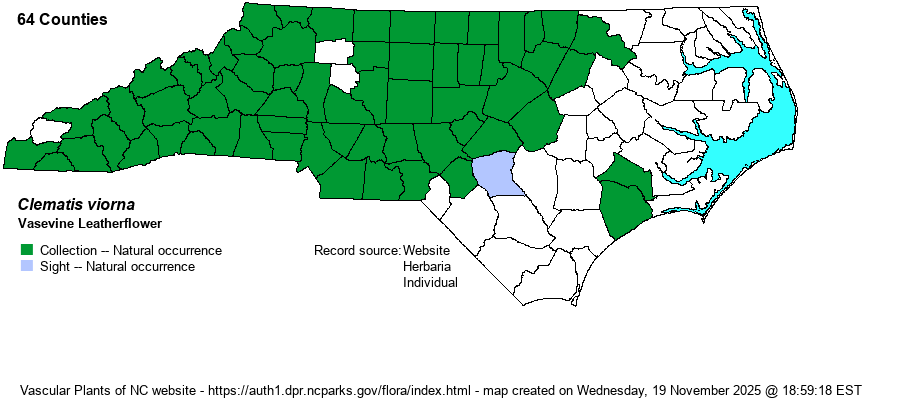| Author | L. | |
| Distribution | Note that Weakley (2024) has accepted the split of C. beadlei from this species; that species was formerly just named as Clematis species 9, by NatureServe. This new species is not scarce over the Piedmont, though is scarce in the upper Coastal Plain; however no specific details of range (i.e., counties) have been presented. As a result, the map below may well contain records just of this new species and thus be incomplete and "overstated".
Throughout the Mountains and Piedmont; barely ranging into the Coastal Plain, though disjunct to the central coast in marl-dominated habitats. Apparently ranges barely into the western Coastal Plain along the Cape Fear River and Little River.
This is an East-central species, ranging north just to southern PA and MO, and then south to southern GA and AR. | |
| Abundance | Frequent to common across the Mountains and Piedmont, generally just slightly less numerous in these regions than is C. virginiana. Very rare in the Coastal Plain -- extreme western margins and in the Jones/Onslow county region, but absent in most areas. | |
| Habitat | This is a species of mesic forests and edges, preferably over circumneutral soil or just barely acidic soil. It favors edges and openings, in partial shade; thus, it is most often seen in open mesic hardwood forests, edges of hardwood forests, glades and barrens, and in mesic to slightly damp thickets. It can occur in rocky wooded soils and open rock ledges. | |
| Phenology | Blooms from May to September, and fruits shortly after flowering. | |
| Identification | This is another of the herbaceous vines in the genus, it often reaching to 10 feet or more long. It has opposite leaves, each of which is pinnately-divided into 3-9 leaflets. Each leaflet is ovate to lanceolate, about 2 inches long, entire on the margins, but some may be strongly cleft and not simply just ovate. The scattered flowers are mostly solitary at a branch tip or from a leaf axil. Each is purple-rose in color, the usually 4 sepals (no petals) being very thick and fleshy, with the shape of the 1-inch-long flower being a "closed-looking" vase or urn with slightly turned up sepal tips, usually facing downward. When in bloom, the purplish color of the flowers are quite obvious, but when just in leaf you could walk past it without noticing. The only other similar species in its range with these entire leaflets is the exotic C. terniflora; it normally grows in strongly disturbed or waste areas, but habitats can overlap. The flowers are very different, as that species has white flowers in clusters and widely spread, as in C. virginiana. The Coastal Plain C. crispa may overlap in range, barely; its leaves are very similar, but it has blue flowers with wide-spreading sepal tips in a bell shape. All of these species have the characteristic "curly-heads" ball of fruit, often 2 inches across; though easily spotted on the vines, they usually are not helpful in distinguishing among the other Clematis species. This is a species that should be readily found by biologists working in the mountains and Piedmont along wooded edges, wide trail margins though forests, and other lightly-shaded areas in mesic -- yet in rich-soil -- conditions.
NOTE: The recently split out C. beadlei from C. viorna means that some of the description above may well refer to this new species. This new species has "Leaves thick, pseudo-reticulate, the leaf veins pronounced but not raised; peduncles and sepal exterior surfaces pubescent; sepal exterior magenta pink, the interior white" (Weakley 2024), wheras the sensu strictu C. viorna has "Leaves thin, membranous, the leaf veins obscure; peduncles and sepals glabrous or puberulent; sepal exterior cherry red, the interior cream" (Weakley 2024). | |
| Taxonomic Comments | See above. This formerly widespread species has had C. beadlei pulled out from it (in 2022); this latter species appears to be restricted just to a small area of NC, SC, and n. Georgia, mainly in the Piedmont.
| |
| Other Common Name(s) | Vase-vine, Northern Leatherflower. The species is often called just "Leather-flower", but quite a few other species in the genus have that as part of the common name, and thus that name is not acceptable for C. viorna. Many use Vase-vine, a suitable name, though that is idiosyncratic. NatureServe uses Vasevine Leatherflower, which this website adopts as being the best name. | |
| State Rank | S5 | |
| Global Rank | G5 | |
| State Status | | |
| US Status | | |
| USACE-agcp | | |
| USACE-emp | | |

